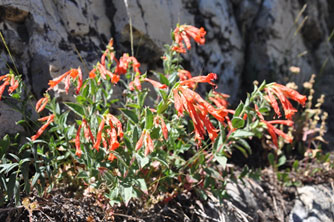Firechalice in the Landscape

Stephen Love, University of Idaho
Scientfic Name: Zauschneria garrettii (Epilobium canum)Common Name: Firechalice or Hummingbird Flower
Description: Firechalice is a long-lived, herbaceous perennial that dies back to the ground during winter and emerges from the roots in spring. The plant is relatively small, usually 12 to 18 inches tall. The branches are thin, supple, and tend to arch. The medium-green leaves are distributed along the entire length of the stems, including into the inflorescence. The flowers are bright orange-red, trumpet-shaped, and droop downward. The bloom period is exceptionally long, lasting from June until frost. It is an outstanding hummingbird plant. Firechalice is a good subject for the front of any bed, border, or rock garden. (Photograph complements of Richard Anderson, Utah Botanical Center.)
Native Habitat: Epilobium canum can be found in remarkably diverse regions of the western United States. It has been discovered in all western states except Washington, Montana, and Colorado. It is known from locales with elevations ranging from sea level to over 10,000 feet. Its habitat is typically open, steep, dry, and rocky and is accompanied by sagebrush, mountain scrub, grasses and other small wildflowers.
Cultural Requirement
Soil: Grows well in almost any soil except those that are poorly drained. Tolerates a wide range of soil pH.
Moisture Tolerance: Moderately xeric. Requires some supplemental irrigation to remain attractive throughout the season.
Sun/Shade/Preference: Blooms best in full sun but tolerates part-shade.
Transplanting: Tolerates all routine nursery handling procedures. Plants can handle long-term residence in pots and still remain attractive.
Propagation: Seed from this species often displays erratic and low emergence. Best propagated from rooted stem cuttings. For best success, use young, tender stems, without flowers or seed capsules. Some success can also be had with root cuttings or division of large plants.
Maintenance (pruning, fertilization, deadheading, division, irrigation, etc): Plants continue blooming through the season without deadheading. Supplemental irrigation is needed (four to six times during each summer) to keep plants actively growing and attractive. Occasional fertilization may help plants perform at their best.
Insect, disease, or other problems: Firechalice has no serious insect or disease problems.
Landscape Value
Use in the Landscape: Firechalice is a low, spreading or arching plant. It is best used in front of larger plants or in small beds and borders. It is one of our best native rock garden plants, and can be used effectively to accent terraces and other locations with an incline. Due to its long bloom period and blazing flower color, firechalice can be used to add color to almost any site. Firechalice can be used in either naturalized or formal designs. Although xeric by nature, it also thrives in traditional landscapes.
Foliage: The leaves are medium-green with slightly toothed edges. The plants produce no basal leaf mat and the leaves grow only on the flowering stems. The plants have a leafy look, even when in flower.
Timing: June - Oct
Color: Lavender
Fruit: An elongated capsule. Each capsule holds numerous fuzzy seeds.
Form: Loosely mounded to spreading or slightly arching.
Texture: Moderately fine.
Ultimate Size: In or out of bloom – 12 to 18 inches tall (occasionally taller). The plants are variably (but not usually aggressively) rhizomatous and some older plants can be much wider than tall.
Rate of Growth: Moderately fast. The plants bloom the first year. The plants increase in width and number of flowering stems as they age.
Suggested Plant Partners: Plant firechalice with among nearly any combination of low-growing forbs and grasses or in front of taller landscape elements. Most Penstemon species make good companions. Other good partners include Eriogonum umbellatum, Eriogonum compositum, Eriogonum niveum, Baileya multiradiata, Artemisia frigida, Sorghastrum nutans, Chamaebatiaria millefolium, Ribes aureum, and almost any other species that provides the desired color combinations.
Availability: Local and mail order native plant nurseries often carry Zaushneria garrettii as potted plants. Seed can be purchased from some native plant seed suppliers.
Cultivars: Zauschneria garrettii has been combined with many of its close relatives into the single species Epilobium canum, meaning it is now more difficult to know if a cultivar will have provenance that instills hardiness. “Mountain Flame” was selected from Zauschneria garrettii and is hardy. ‘Catalina’, ‘Orange Carpet’, and ‘Silver Select’ were selected from southern locales and may be less hardy.
References:
Denver Water. 1996. Xeriscape Plant Guide: 100 Water-Wise Plants for Gardens and Landscapes. Fulcrum Publishing, Golden, Colorado.
Love, S.L., Noble, K., Robbins, J.A., Wilson, B. and McCammon, T. 2009. Landscaping with Native Plants. University of Idaho Bulletin #862
Nicholls, G. 2002. Alpine Plants of North America: An Encyclopedia of Mountain Flowers from the Rockies to Alaska. Timber Press, Portland, Oregon.
Nold, R. 2008. High and Dry: Gardening with Cold Hardy Dryland Plants. Timber Press, Portland, Oregon.
Robson, K.A., Richter, A. and Filbert, M. 2008. Encyclopedia of Northwest Native Plants for Gardens and Landscapes. Timber Press, Portland, Oregon.

